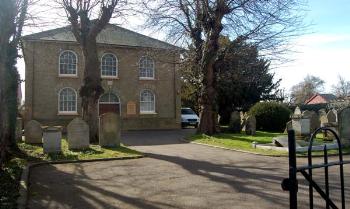Clifton Baptists

Clifton Strict Baptist Church in March 2007
Volume 110 published by the Bedfordshire Historical Records Society in 1996 and edited by Edwin Welch contains registrations of Bedfordshire nonconformist meetings drawn from a number of sources. The first entry for Clifton is of the registration of the house of Isaac Bedford by the Congregationalists on 16th May 1672. At this early date the term is often used interchangeably with Baptist and Anabaptist. The Baptists were a church based on the teachings of 16th century reformer John Calvin and his belief that Jesus Christ died and was resurrected only to pardon the sins of certain individuals - who were known as the elect.
Visitations by the Bishop of Lincoln to Bedfordshire in the early 18th century give some idea as to the number of Baptists in Clifton from returns made by the rector. Former County Archivist Patricia Bell has compiled returns from 1706 to 1720 for the Bedfordshire Historical Records Society (Volume 81, published 2002). In 1706 the parson recorded that the parish had about fifty families: "Of these 6 are of dissenters, 5 Anabaptists [Baptists] and 1 Quaker. In 1709 he numbers of nonconformists were, out of a total of fifty four families: "6 Quakers, 14 Presbyterians, and a few occasional Dissenters. Presumably the term Presbyterian is here used instead of Baptist. By 1712 eight families were recorded as Independents, certainly another term interchangeable with Baptists at this date. In 1717 the return for nonconformists gives numbers of families for 1711 and 1715 as well: Independent families rose from six to eight, then fell back to seven. In 1720 six families were given as being Independents.
In November 1776 William Albone's dwelling house was registered by William Tansley and John Harrison [ABN1/1 and 2/40]. Tansley also registered meeting houses in other parishes, including Haynes, in 1766, where the application to register is addressed to the "Commissary & Official" of the Archdeaconry of Bedford and it is noticeable that this form of address is used in other, known Baptist, applications. This is by no means certain but the Baptists have always been the largest nonconformist denomination in Clifton and so it is a working supposition.
In November 1840 a man named Septimus Sears preached at Southill. He made such an impression that the people from Clifton asked him to come and be their minister. There was no Chapel at that time but George Kempson promised to turn two of his cottages at Clifton Fields (now 64 Clifton Road, Shefford) into a Chapel if Sears would accept their offer. He did accept and he moved to the village, living in what is now Holly Lodge, 114 Clifton Road, Shefford in September 1842. The chapel had been registered by George Millard, Thomas Fane, Thomas Kent, Thomas Pope, Thomas Arnold, James Young, George Thompson, James Roberts and Thomas Rainden in 1841 [ABN1/2 and ABN2/355].
Towards the end of the eighteenth century Andrew Fuller had modified some aspects of Baptist teaching around membership and communion and teaching that jesus Christ died for all, not just the elect. This occasioned a split between his new General Baptists and the original Particular Baptists, now often referred to as Strict Baptists. The Clifton chapel was a Particular Baptist meeting. The group in Clifton was on an informal basis to start with and began properly in February 1844 when Sears baptised six people in the River Ivel.
On Sunday 30th March 1851 an ecclesiastical census was held in which every place of worship in the country had to make a return of people attending the various services held that day. The return for the chapel in Clifton Fields was given by the deacons, John Thornby and James Turner. The chapel had 30 free seats and 260 reserved and that morning 200 adults and 90 Sunday scholars had been in attendance, with 300 adults and the same number of scholars in the afternoon. These figures easily beat the figures for both the parish church and the Wesleyan Methodists in the village combined.
The large chapel in Broad Street was built in 1853 on land given by Samuel Wilson of Elms Farm. The chapel could hold 700 after galleries were constructed in 1863. Bedfordshire and Luton Archives and Records Service has the following records for Broad Street Baptist Church:
- CRT180/444: notes on the life of Septimus Sears by B. Livesey: 1819-1877;
- Bedfordshire Times : tenders invited for building the chapel: 29 Jan 1853;
- X365/1: The Clifton Selection with Many Original Psalms, Hymns and Spiritual Songs: c. 1870;
- X365/2: Clifton Hymns: A Service of Song for United Worship Consisting of Hymns Original and Select by the Editor of the 'Little Gleaner' and the 'Sower': c. 1870;
- X365/6: The Little Gleaner: A Monthly magazine for the Young: 1871;
- X365/7: The Sower a monthly magazine: 1877;
- X365/8: memoir of the Life and Labours of the Late Septimus Sears, who was for thirty five years Minister of the Gospel of Christ, at Clifton, Bedfordshire: 1880;
- X365/3: Clifton Hymnal for the Young Selected, with many Originals, by the Editor of the 'Little Gleaner' and the 'Sower': 1882;
- X414/160: marriage certificate: 1905;
- Z251/330: postcard showing the chapel exterior: c. 1906;
- X365/4: Clifton Hymnal for the Young Selected, with many Originals, by the Late Septimus Sears: 1925;
- X704/76: posters detailing anniversary services etc.: 1951-1970;
- X365/5: Clifton Hymnal for the Young: c. 1966;
- Z50/30/17-19: exterior photographs of the chapel undergoing repairs: 1981;
- PCClifton18/7: plans for alterations to access to the chapel: 1983;
- Z50/30/41: Photograph of Septimus Sears' gravestone: 1985